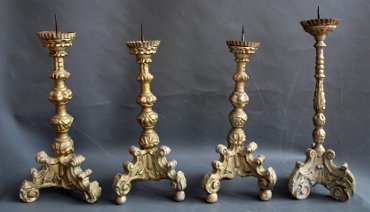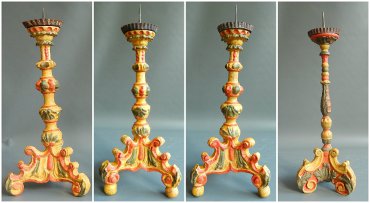
|
Slika 1. |
|
Slika 2. |
Konzervatorsko-restauratorski radovi na drvenim polikromiranim svijećnjacima iz kapele sv. Filipa i Jakova u Gradišću
Diplomski rad, Paula Bule
Mentorica: izv. prof. mr. art. Zvjezdana Jembrih
SAŽETAK
U ovom radu prikazani su konzervatorsko-restauratorski radovi na drvenim polikromiranim svijećnjacima iz kapele sv. Filipa i Jakova u Gradišću, te je ukratko prikazana liturgijska uloga svijećnjaka kroz povijest.
Na poziv Konzervatorskog odjela u Zagrebu 8.11. 2013. godine u kapeli sv. Filipa i Jakova u Gradišću izvršeno je istraživanje inventara in situ, s ciljem preuzimanja svijećnjaka i kanonskih pločica, koji su dio inventara te kapele, radi izvođenja konzervatorsko-restauratorskih radova. Odlučeno je da konzervatorsko-restauratorski radovi na svijećnjacima budu predmet ovoga diplomskoga rada.
Konzervatorsko-restauratorski radovi na drvenim polikromiranim svijećnjacima obuhvaćali su: istraživanje inventara kapele in situ, preuzimanje svijećnjaka, dezinsekciju gama zračenjem, vizualni pregled svijećnjaka, uklanjanje površinske prljavštine, sondiranje, probe uklanjanja preslika, analizu pigmenata XRF-om i FTIR analizu veziva, konsolidaciju drvenog nosioca, uklanjanje preslika, lijepljenje odvojenih dijelova nosioca, nadoknade u sloju nosioca i osnove, retuš izvornog oslika, završno lakiranje, izradu cjelovite dokumentacije, te povratak i smještaj svijećnjaka u kapelu.
Radovi su počeli in situ u kapeli, pakiranjem i prijevozom. Svijećnjaci su dopremljeni na Odsjek za konzerviranje i restauriranje umjetnina (OKIRU) Akademije likovnih umjetnosti u Zagrebu (ALU) radi izvođenja potrebnih konzervatorsko-restauratorskih radova. Prije dolaska na Odsjek, svijećnjaci su bili podvrgnuti gama zračenju na Institutu Ruđer Bošković u Zagrebu, radi obavljanja dezinsekcije. Tijekom konzervatorsko-restauratorskih radova svijećnjaci su se nalazili u kontroliranim mikroklimatskim uvjetima, pri temperaturi 18-23 °C i relativnoj vlažnosti zraka 55-65 %.
Vizualnim pregledom svijećnjaka ustanovljeno je da je potrebno ukloniti površinsku prljavštinu, te izvesti sondiranje u svrhu identifikacije kronoloških slojeva. Većina oštećenja vjerojatno je nastala u kapeli u kojoj su svijećnjaci bili izvorno smješteni, no na sadašnje stanje svijećnjaka znatno je utjecalo i njihov neodgovarajući smještaj iza glavnog oltara, vjerojatno nakon što su prestali biti u funkciji. Detaljnim pregledom utvrđeno je da im je nosilac u relativno dobrom i stabilnom stanju, ali da su prisutna manja mehanička oštećenja, te da nedostaju neki dijelovi nosioca. Jedan od svijećnjaka je pronađen u izrazito krnjem obliku - pronađen je samo gornji dio Svijećnjaka br. 5.
Sondiranjem se potvrdila pretpostavka da su svijećnjaci u cijelosti preslikani metalnim prahom u uljnom vezivu, te da se ispod preslika nalazi izvorni oslik na izvornoj kredno-tutkalnoj osnovi. Izvorna polikromija je žuta, tamnozelena i crvena - pojedinačne boje slijede formu svijećnjaka.
Pokazalo se da je izvorni oslik u dobrom stanju, te da predstavlja zanimljiv način izvornog polikormiranja - svojevrsnu skromnu varijaciju izgleda bogatijih pozlaćenih, posrebrenih i lazuriranih onodobnih svijećnjaka.
Preslik je estetski degradirao izgled ovih svijećnjaka.
Na temelju tih saznanja odlučeno je da će se izvršiti uklanjanje 2. kronološkog sloja - preslika - metalnog praha u uljnom vezivu. Izvedene su probe uklanjanja preslika na Svijećnjaku br. 4, kako bi se utvrdila najprimjerenija metoda uklanjanja preslika. U tijeku uklanjanja preslika izvršene su XRF I FT-IR analize u svrhu identifikacije sastava i veziva pigmenata izvornog oslika i preslika.
Nakon uklanjanja preslika, svijećnjaci su podvrgnuti konsolidaciji drvenog nosioca.
Odlomljeni dijelovi svijećnjaka - nožice na svijećnjaku br. 4 i kuglica na svijećnjaku br. 2 konsolidirani su i zalijepljeni uz cjelinu.
Zatim su izvedene nadoknade oštećenja u sloju nosioca i osnove, te su uslijedili retuš izvornog oslika i završno lakiranje.
U dogovoru s nadležnim Konzervatorskim odjelom svijećnjaci će biti vraćeni u kapelu i bit će smješteni na menzu glavnog oltara na svoje izvorno mjesto.
Konzervatorsko-restauratorski radovi su popraćeni cjelovitom pisanom, grafičkom i fotografskom dokumentacijom.
Teorijski dio diplomskog rada obuhvaća osvrt na liturgijsku ulogu svijećnjaka kroz povijest, povijesno - kulturološku simboliku svjetla, te kratki povijesno-umjetnički pregled svijećnjaka kao svjetovnih i liturgijskih predmeta.
Diplomskom radu su priložene stratigrafske tablice, grafički prikazi, rezultati XRF I FTIR analiza, fotografska dokumentacija, te popis literature.
SUMMARY
This paper deals with the conservatory and restoration works, made on wooden polychrome candle holders from the Saint Filip and Saint Jakov Chapel in Gradišće, as well as with the liturgical role of the candle holders throughout history.
Called by Conservatory department in Zagreb, on November, 8th 2013 in the Chapel of Saint Filip and Saint Jakov in Gradišće, the research of the in situ inventory was made, with the aim of taking over the candle holders and canonical tablets – that are the inventory part of the chapel – in order to make restoration and conservatory works. It was decided that the restoration and conservatory works on the candle holders will be the central point of this paper.
Restoration and conservatory works made on the wooden polychrome candle holders covered the following: the in situ inventory of the chapel, taking over the candle holders, fumigation with gamma rays irradiation method, visual overview of the candle holders, the removal of the areal dirt, sounding, the removal of the copy probes, the pigment XRF analysis, as well as the FT-IR connective tissue analysis, consolidation of the wooden carrier, gluing of the separated parts of the carrier, compensations in the layer of the carrier and the basis, retouching of the original mural, the final varnishing, followed by making of the complete documentation, as well as bringing back the candle holders to the chapel.
The works had begun in situ, in the chapel by packing and the transport. The candle holders were brought to the Department of art conservatory and restoration (OKIRU) at the Academy of Arts in Zagreb (ALU) in order to make necessary conservatory and restoration works. Before arrival to the Department, the candle holders had been submitted to gamma rays irradiation method, at the Ruđer Bošković Institute in Zagreb, in order to make fumigation.
During the conservatory and restoration works, the candle holders were placed in controlled microclimate conditions, under the temperature of 18 – 23 C and relative air humidity of 55 – 65 %. By visual overview of the candle holders, it was realized that the necessary removal of the areal dirt must be made, as well as to make sounding in order to fumigate chronological layers.
Most of the damage probably disappeared in the chapel, where the candle holders had been originally placed, but for the present state of the candle holders - much of the influence is due to the inappropriate placement behind the main altar; most probably after they stopped being used. By the detailed overview, it was concluded that the carrier of the candle holders was in pretty good condition, with minor mechanical damages, and that certain parts of the carrier were missing. One of the candle holders was found in the extremely truncated form; the only upper part of the Candle holder number 5.
By the sounding, the assumption was confirmed that the candle holders had been completely covered by metal powder in oil connective tissue, as well as that under the copy there had been original mural on the original glue and cretaceous basis. The original polychrome is yellow, dark green, and red; the individual colors follow the form of the candle holders.
It has been shown, that the original mural is in good condition, and that it represents an interesting way of original polychrome – a certain variation in the appearance of the rich golden plated and silver plated candle holders, that had been made in those times.
The copy was degraded aesthetically, in comparison to the appearance of these candle holders.
On the bases of this knowledge, it was decided that the removal of the second chronological layer – the copy – of the metal powder in oil connective tissue will be made. The copy removal probes were made on the Candle holder number 4, in order for the most appropriate copy removal method to be used. During the removal of the copy, already mentioned XRF and FT-IR analysis were made, due to identification of the content and connective tissue of the original, mural and the copy. After the copy removal, the candle holders were submitted to the consolidation of the wooden carrier.
The parts of the candle holders that had been broken off – legs of the candle holder number 4 and the pallet of the candle holder number 2 were consolidated and glued into the coherent whole. After that, the compensation of the damages in the layer of the carrier and the basis were made, after which the retouching of the original mural was done, followed by the final varnishing.
In the agreement with the competent Conservatory department, the candle holders will be brought back to the chapel, and placed at the mess behind the mail altar, where is their original place.
The conservatory and restoration works are followed with the complete written, graphical and photographical documentation.
Theoretical part of this diploma paper, covers the review of the liturgical role of the candle holders throughout history, as well as historical and cultural symbolism of the light, together with the short historical and artistic overview of the candle holders viewed as secular and liturgical objects.
This diploma paper is attached by stratigraphical tables, graphical representations, the results of XRF and FT-IR analysis, as well as the photographic documentation, followed by the bibliography at the end.

